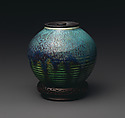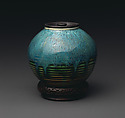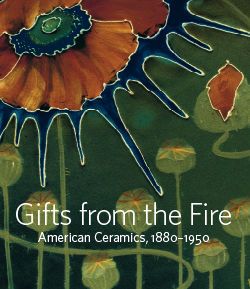Covered Vase
Adelaide Alsop Robineau American
Adelaide Alsop Robineau was a consummate craftsman and a brilliant designer, who, working on her own, tackled the challenging medium of porcelain in an era when the medium was the domain of large-scale commercial factories. Like many talented women of her era, she began her career as a china painter and teacher, and with her husband, Samuel Robineau, founded the extraordinarily influential periodical Keramic Studio (later Design). She was a pioneer in the field of ceramics, and challenged traditional gender roles in her trail-blazing career, throwing the clay herself, decorating, and glazing her vessels. Her artistic porcelains are today acknowledged to surpass the work of any other American studio potter.
This nearly spherical vase shows pronounced throwing rings on its exterior surface, a feature found from time to time on Robineau’s work dating to the teens and twenties. A thick brilliant turquoise and blue glaze drips over the more translucent glaze below. Robineau often crafted decorative porcelain lids for vases that she felt were worthy. Here, the carved lid is covered in a matte gun-metal dark glaze to simulate metal. The Chinese or Chinese style wooden base bears an original paper label with Robineau’s monogram, indicating that it was original to the piece.
Through her exceptional work which was exhibited widely both throughout the United States and abroad and both her editorial voice and articles in Keramic Studio, Robineau left an indelible print on the history of American ceramic, and was significant in paving the way for American studio potters that follow in the decades after her death.
This image cannot be enlarged, viewed at full screen, or downloaded.
This artwork is meant to be viewed from right to left. Scroll left to view more.




